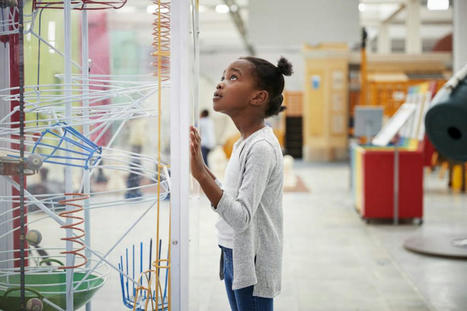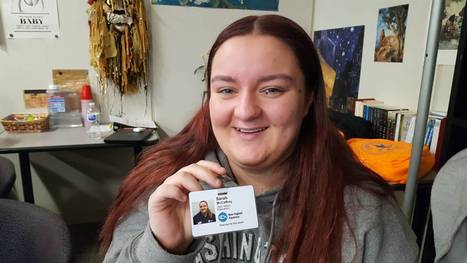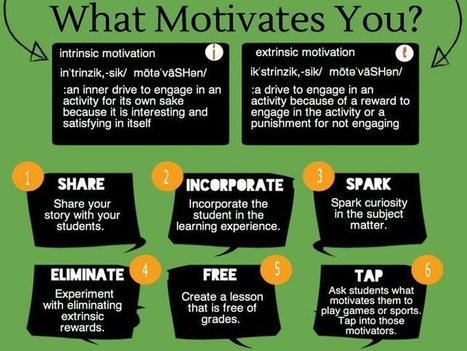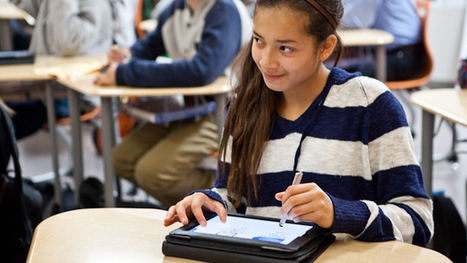 Your new post is loading...
 Your new post is loading...

|
Scooped by
John Evans
|
If there’s one concern about distance learning that educators have during these times, it’s that students are having difficulty being motivated. A lack of motivation is perfectly understandable given the severity of the pandemic, the financial hardships and the shortcomings of video conferencing platforms. But that doesn’t necessarily mean teachers can’t prioritize motivation and curiosity, which were already suffering pre-pandemic because of the way schools often rely on tests and grades to drive student learning.
Educators navigating distance learning are grappling and experimenting with ways to capture students’ interest through social media, polls and stickers on their faces. In addition to those strategies, they've also found ways to stoke curiosity and motivation that are not completely out-of-the-box solutions.

|
Scooped by
John Evans
|
Kathy Digsby has been teaching elementary school for a long time. She taught kindergarten for many years, then transferred to first grade. And even though she’s approaching sixty and planned to retire soon, part of her doesn’t want to leave the classroom. Recently she’s been mixing it up, injecting choice into as many areas of the classroom as she can to engage her young learners. And it’s exciting.
“I think as teachers we feel like we have to be in control of everything in order for the kids to be okay and for them to learn,” Digsby said. A classic example is the “daily five” stations students rotate through during English Language Arts time. At one table, Digsby usually works on guided reading with a small group. Every 20 minutes, kids rotate between stations where they read to themselves, work on writing, do word work, or practice a skill on the computer. When the timer goes off students rotate, whether they’re done with the task or not.

|
Scooped by
John Evans
|
Kathy Perez has decades of experience as a classroom educator, with training in special education and teaching English language learners. She also has a dynamic style. Sitting through her workshop presentation was like being a student in her classroom. She presents on how to make the classroom engaging and motivating to all students, even the most reluctant learners, while modeling for her audience exactly how she would do it. The experience is a bit jarring because it’s so different from the lectures that dominate big education conferences, but it’s also refreshing and way more fun.
Perez says when students are engaged, predicting answers, talking with one another and sharing with the class in ways that follow safe routines and practices, they not only achieve more but they also act out less. And everyone, including the teacher, has more fun.
“If we don’t have their attention, what’s the point?” Perez asked an audience at a Learning and the Brain conference on mindsets.

|
Scooped by
John Evans
|
There is one simple change I made as a teacher (and a change many teachers have made around the globe), that provides more opportunity for motivation, engagement, and empowerment than anything else I’ve seen.

|
Scooped by
John Evans
|
Lots of factors affect whether and what students learn in school, but most often that conversation gets boiled down into a single letter grade, a symbol of everything a student knows or doesn’t know. Because grades are often required, and easy to understand, they have become the focus for many parents, teachers and students. The problem is that grades are often subjective, arbitrary and can be demotivating to students. They are also gatekeepers for advanced classes and college admissions, so grades can’t be ignored. This complicated dynamic means that grading policies are at the center of discussions around how to change teaching and learning.

|
Scooped by
John Evans
|
Winnie the Pooh has been around since 1924. He has lead many of us through the Hundred Acre Wood with his fun adventures.
He has shared with us inspiring wisdom that will forever resonate in our hearts. Even though this article does not really do this justice it is a small look into the priceless wisdom that was given.
|

|
Scooped by
John Evans
|
Most teachers intrinsically understand the need to motivate their students, experts say, but teaching on intuition alone can lead to missteps in student engagement.
A study released in May by the Mindset Scholars Network, a collaborative of researchers who study student motivation, found most teacher education programs nationwide do not include explicit training for teachers on the science of how to motivate students.
That’s why some teacher education programs are exploring ways to help teachers learn how to engage their students in deeper ways.

|
Scooped by
John Evans
|
Destiny, 18, is like most students in the United States. Surveys reveal a steady decline in student engagement throughout middle and high school, a trend that Gallup deemed the “school engagement cliff.” The latest data from the company’s Student Poll found that 74 percent of fifth graders felt engaged, while the same was true of just 32 percent of high school juniors.
One of the key components of engagement is students’ excitement about what they learn. Yet most schools extinguish that excitement.

|
Scooped by
John Evans
|
We’ve talked about the definition of intrinsic motivation in the past. We’ve also talked about some basic ways to improve student motivation.
This time, it’s Mia MacMeekin‘s turn to speak to you about the same, but through gridded, blocked, and easy to read infographics. The graphic starts with a definition for both intrinsic motivation and extrinsic motivation, then offers 27 verbs that can help promote that magic stuff that is characterized by curiosity, effort, engagement, and academic success.
Some were a little iffy–“praise” and “milestones” seemed a little closer to extrinsic motivation. But the vast majority are useful to consider as you design units, lessons, and activities this school year.
Have you ever thought about why you do the things you do?What is it that really prompts your behaviors?Motivation can be either extrinsic or intrinsic, meaning it can either come from outside or inside of a person. Extrinsic motivation comes when you feel the urge to do something in order to gain a specific reward, …
Via Ariana Amorim, Dean J. Fusto

|
Scooped by
John Evans
|
Using Concept-Oriented Reading Instruction (CORI) or practices to encourage engagement, educators can advance the breadth and depth of students' reading by explicitly and systematically nourishing students' motivations as readers.

|
Scooped by
John Evans
|
Educators have lots of ideas about how to improve education, to better reach learners and to give students the skills they’ll need in college and beyond the classroom. But often those conversations remain between adults. The real test of any idea is in the classroom, though students are rarely asked about what they think about their education.
A panel of seven students attending schools that are part of the “deeper learning” movement gave their perspective on what it means for them to learn and how educators can work to create a school culture that fosters creativity, collaboration, trust, the ability to fail, and perhaps most importantly, one in which students want to participate.
|
 Your new post is loading...
Your new post is loading...
 Your new post is loading...
Your new post is loading...
























